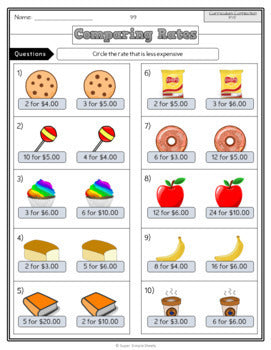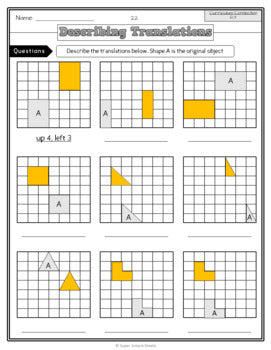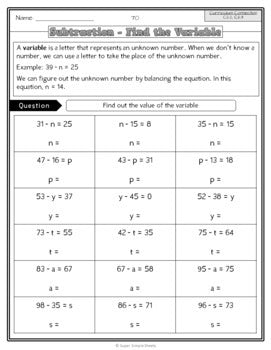Grade 5 - Full Year Math Bundle - Ontario New 2020 Curriculum
Grade 5 - Full Year Math Bundle - Ontario New 2020 Curriculum
Interested in a bundle? Shop below instead!
Couldn't load pickup availability
PRODUCT PREVIEW
Grade 5 - New Ontario Math Curriculum 2020 – This bundle covers all expectations in the Grade 5 - New Ontario Math Curriculum. Included are 1,044 activity sheets for your students to learn the overall and specific expectations outlined by the Ministry of Education.
Check out each of the strands below to learn more about the resources included in this bundle.
Strand B - Number (Number Sense and Operations)
- Composing and decomposing whole numbers to 100 000
- Using base ten blocks to represent numbers up to 100 000
- Comparing and ordering numbers to 100 000
- Equivalent fractions
- Improper Fractions and Mixed Numbers
- Comparing, ordering and adding decimals to the hundredths place value
- Understanding the relationship between fractions, decimals and percent
- Round decimals to the nearest tenth
- Number line addition, subtraction, multiplication, division
- Fact Families – Relationship between multiplication and division
- Multiplication and division facts – 1 through 12
- Addition mental math strategies (adding in chunks, counting on, doubling, and more)
- Subtraction mental math strategies (adding up, counting back, subtracting in chunks)
- Multiplying and dividing by 0.1 and 0.01
- Standard algorithms – addition, subtraction, multiplication, division up to 100 000
- Estimating and solving addition and subtraction
- Add and subtract fractions with like denominators
- Arrays – Multiplication and Division
- Multiplying and dividing using area models
- Multiplication and division of fractions (repeated addition, subtraction)
- Multiplying of whole numbers by fractions
- Ratios and unit rates
- Equivalent rates and ratios
- 3 Unit Quizzes – Place Value, Numbers, Operations
Strand C - Algebra (Patterns, Equations, Coding)
- Repeating Patterns (different shapes, sizes, colours, orientations)
- Translating growing and shrinking patterns using tables of values and graphs
- Increasing/Decreasing patterns using all 4 operations (addition, subtraction, multiplication and division)
- Determining pattern rules and pattern cores
- Extending growing, shrinking, and repeating patterns
- Determining pattern core in repeating patterns
- Table of Values
- Creating and describing patterns using whole numbers and decimal to the hundredths
- Graphing table of values
- Pattern Blocks
- Investigating decimals patterns using number strings
- Solving using variables
- Balancing equations using all 4 operations
- Evaluating equations deciding if they are equal (balanced)
- Solve inequalities involving the addition and subtraction of whole numbers to 100
- Writing code
- Interpreting code
- Using loops in code
- Concurrent codes – writing codes for events that happen simultaneously
- Conditional codes – If and Then codes
- Coding games using if/then codes
- 3 Unit Tests – 1 for each overall expectation
Strand D - Data (Data Literacy and Probability)
- Difference between qualitative and quantitative data
- Difference between primary and secondary data
- Understanding the importance of random sampling
- Investigating the different random sampling techniques
- Using tally marks
- Using frequency tables
- Interpreting bar graphs and stacked-bar graphs
- creating pictographs, bar graphs, and stacked-bar graphs
- determining the mean, median, and mode of data sets
- Creating and interpreting stem-and-leaf plots
- Creating an appropriate scale for a graph
- Creating and interpreting infographics
- Drawing conclusions about different sets of data
- Thinking critically about misleading graphs
- Creating misleading graphs
- Describing the likelihood of an outcome (impossible, unlikely, equally likely, likely, and certain)
- Using a probability line to decide the probability of an event
- Using fractions to represent the probability of an event
- Understanding the difference between theoretical and experimental probability
- 2 Unit Tests - Data Literacy and Probability
Strand E - Spatial Sense
- Geometric properties of triangles (sides, angles)
- Types of triangles based on angle – obtuse, acute, right, straight
- Types of triangles based on side lengths – scalene, equilateral, isosceles
- Congruent triangles, rectangles and parallelograms
- Drawing top, front, and side views of objects
- Reading and plotting coordinates in the first quadrant using different scales
- Describing translations and reflections of shapes on a coordinate plane
- Translating, reflecting and rotating shapes on a grid
- The relationship between metric units of measurement (grams and kilograms, metres and centimetres and millilitres and litres)
- Converting units of measurement
- Measuring lengths using appropriate tools
- Estimating lengths, mass, and capacity of different things
- Comparing angles by estimating angle size
- Using a protractor to determine angle size
- Draw angles and triangles using a protractor
- Find the area and perimeter of rectangles, triangles, and parallelograms
- Use the formula for area to determine the unknown measurement in rectangles, parallelograms and triangles
- Understand that two-dimensional shapes with the same area can have different perimeters
- 2 Unit Tests - Geometry and Measurement
Strand F - Financial Literacy
- Methods of Payment – Reading
- Methods of Payment – Questions
- Different Forms of Payment – Reading
- Different Forms of Payment – Questions
- Transferring Money – Research Assignment
- Counting Dollars
- Counting Cents
- Converting Cents to Dollars
- Counting Canadian Coins
- Counting Money
- Calculating Change Using $1
- Calculating Change Using $2
- Calculating Change Using $5
- Calculating Change Using $10
- Calculating Change Using $20
- Calculating Change Using $50 & $100
- Providing Change to Customers
- Estimating Sales Tax
- Estimating Sales Tax – Word Problems
- Determining Sales Tax
- Determining Sales Tax – Word Problems
- Determining Final Price with Sales Tax
- Determining Final Price – Multiple Items
- Determining Final Price – Multiple Items – Word Problems
- Challenge – Restaurant Menu
- Budgets – Financial Plans
- Budget – Creating a Business Plan
- Credit and Debt
- Need vs Want
- Spending and Saving - Reading
- Spending and Saving - Questions
- Introduction to Investing
- Rates
- Rate Word Problems
- Comparing Rates
- Choosing a Service Rate
- Types of Taxes – Reading
- Types of Taxes – Questions
- Unit Test
This is a comprehensive unit that will save you hours of planning! It has been tested and found effective in helping students achieve the learning goals setup by the Ministry of Education in their new math curriculum.
Share





Great for teacher and/or self directed exploration of concepts. Well organized, good assessments, comprehensive units!
Love all SSS math units. Have them for grade 3-5. So comprehensive, easy to use, and love that you can use it as a printable sheet or a digital task.
Use this package for supplementary work for my students.
I am using these sheets to tutor grade 5 math students. I love the simplicity of the sheets. The layout is visually attractive and the sheets have clear, concise directions which are easy to understand. I would not be able to teach without these slides.
Material is very good and having lots of worksheets to practice.








